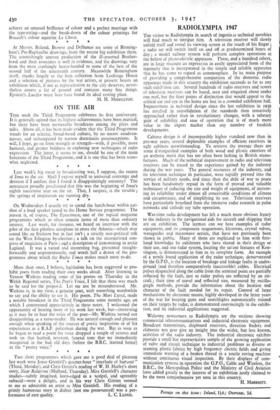ART
NADIA BENOIS, to be known perhaps to art historians of the future as the " Mistress of the Olive Trees," is showing some recent paint- ings at Messrs. Tooth's. They are as sincerely observed and com- petently painted as one would expect of their author, but I must admit that with one or two exceptions I found myself unable to decide just why Miss Benois had felt impelled to put paint to canvas. Many of these works seem to lack that sense of high adventure which comes only with personal exploration and discovery. When this—intensity, if you will—flags, when a picture fails to convey something of that initial excitement which impelled the act of crea- tion, it has, I think, failed in its most important purpose—that of opening our eyes where before we were blind.
* * * Far greater risks are dared by Germaine Richier, some of whose sculpture is to be seen at the Anglo-French Art Centre. The visitor will be well advised to dispense with the farrago of poppycock in the catalogue and concentrate on the work itself. Though mass is dis- torted and surfaces are sliced and scratched and scarred, though her plaster figures are given spindle-like limbs and pin-heads and claw the air in an ungainly and elemental fashion, this work, at its best, has a strange calm and truth and delicacy. The sensitive asymmetry of the heads reveals immense nervous tensions beneath the still surface of the mask. Also on view here are prints by several of the leading figures of the school of Paris, from the studio of Roger Lacouriere, who, for two decades, has played so large a part in France's editions de luxe. Several are old friends ; all have points of technical interest. Among them may be noted the woodcut-mono- types for Pantagruel, upon which Derain passed the. war years—these
achieve an unusual brilliance of colour and a perfect marriage with the typesetting—and the break-down of the colour printings for Rouault's colour aquatint Le Christ.
At Messrs. Roland, Browse and Delbanco are some of Birming- ham's Pre-Raphaelite drawings, from the recent big exhibition there. The astonishingly uneven production of the ill-assorted Brother- hood and their associates is well in evidence, and the drawings vary from the most crashingly heavy-handed to some of the best of the second half of the nineteenth century. Meanwhile Birmingham itself, thanks largely to the loan collection from Lockinge House and a selection of pictures by the war artists, at present boasts an exhibition which, if not as representative as the city deserves, never- theless covers a lot of ground and contains many fine things. Epstein's Lucifer must here have found its ideal resting place.
M. H. MIDDLETON.



































 Previous page
Previous page